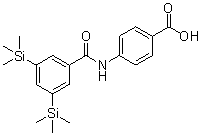All AbMole products are for research use only, cannot be used for human consumption.

TAC-101 inhibits retinoblastoma-gene product (RB) phosphorylation and increases the presence of 2 cyclin-dependent kinase (CDK) inhibitors, resulting in cell cycle arrest. This agent also causes a cytotoxic decline in cyclin A and thymidylate synthase expression. TAC-101 might inhibit MNU induced colon carcinogenesis via a decrease of ACF. The mechanism of this chemoprevention may be related to a reduction in cell proliferation, but is not directly associated with apoptosis. TAC-101 induced transcriptional activation of RAR, resulting in marked elevation of RARbeta, a representative retinoid response marker, and it also significantly repressed the transcriptional activity of AP-1 in JHH-7 cells. TAC-101 did not inhibit AP-1 activity of the JHH-6 cell line, showing that AP-1 interference by TAC-101 must be in parallel with RAR activation. TAC-101 reduced IL-8 production without cytotoxicity and inhibited the progression of HCC in the orthotopic mouse model with decreased tumor IL-8 level. A combination of TAC-101 and cisplatin may be a potential new treatment for ovarian clear cell adenocarcinoma.
| Molecular Weight | 385.60 |
| Formula | C20H27NO3Si2 |
| CAS Number | 125973-56-0 |
| Solubility (25°C) | DMSO |
| Storage |
Powder -20°C 3 years ; 4°C 2 years In solvent -80°C 6 months ; -20°C 1 month |
| Related CDK Products |
|---|
| (E/Z)-Zotiraciclib citrate
(E/Z)-Zotiraciclib citrate is a potent CDK2, JAK2, and FLT3 inhibitor. |
| Abemaciclib metabolites M2
Abemaciclib metabolite M2 (LSN2839567) is a metabolite of Abemaciclib, acts as a potent CDK4 and CDK6 inhibitor, with IC50 values of 1.2 and 1.3 nM, respectively. |
| CDK9-IN-1
CDK9-IN-1 is a novel, selective CDK9 inhibitor, with an IC50 of 39 nM for CDK9/CycT1, it can be used for the research of HIV infection. |
| XO44
XO44 (PF-6808472) is a broad-spectrum covalent kinase probe. |
| ML 315
ML 315 is a selective dual inhibitor of CDK and DYRK with IC50s of 68 nM and 282 nM, respectively. |
All AbMole products are for research use only, cannot be used for human consumption or veterinary use. We do not provide products or services to individuals. Please comply with the intended use and do not use AbMole products for any other purpose.


Products are for research use only. Not for human use. We do not sell to patients.
© Copyright 2010-2024 AbMole BioScience. All Rights Reserved.
